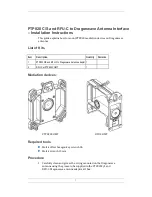
Page 15 of 24
INSTRUCTION MANUAL
AM-741R
ACTIVE MONOPOLE ANTENNA
1912 1 E l T o ro R d
●
Si l vera do, Ca lifo rni a 9 26 76
●
(9 49) 459 -96 00
●
co m-p o wer. com
REV112216
4.3.1
Insertion Loss Measurement
Insertion Loss values for coaxial cables and most measurement system
components having a single coaxial input and output, such as
attenuators, filters, dc blocks, etc., can be easily determined through a
simple calibration process.
All that is typically needed is the following:
9
(2) short coaxial cables and ‘barrel’ adapter to connect them together;
and,
either:
9
a network analyzer or measuring instrument (spectrum analyzer or EMI
receiver) with tracking generator;
or:
9
a measuring instrument (spectrum analyzer or EMI receiver); and,
9
a stable signal source with the appropriate frequency capabilities, such as
a signal generator, function generator, or even a Com-Power Comb
Generator.
4.3.1.1 Insertion
Loss
Measurement Procedure
1)
REFERENCE MEASUREMENTS
(R)
- With the equipment set up as
shown in Figure 3, measure and record the signal level
(in dB
μ
V)
at several frequencies over the frequency range to be
calibrated.
FIGURE 7 -
Setup for Reference Measurements (R)
2)
INSERTION LOSS MEASUREMENTS
(I)
– Without changing any
equipment settings, and with the equipment set up as shown in
Figure 4, measure and record the signal level
(in dB
μ
V)
at the
same frequencies used in Step 1.
FIGURE 8 -
Setup for Insertion Loss Measurements (I)
3)
Calculate the insertion loss factor (in dB) for each frequency
using the following formula:
Insertion Loss Factor = (R) minus (I)
Signal Source
Measuring
Instrument
coaxial cables
‘barrel’ adapter
Signal Source
Measuring
Instrument
coaxial cables
system component
to be calibrated
X










































